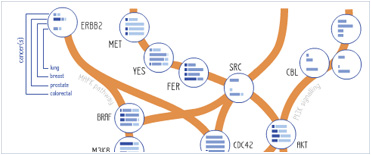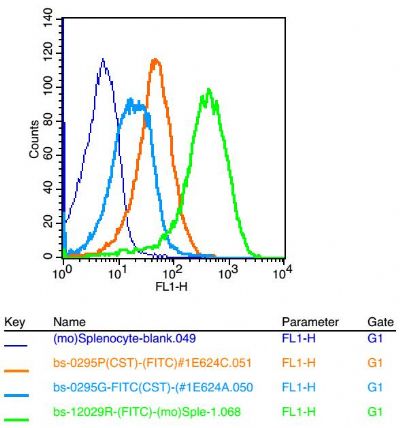GPRC5B Polyclonal Antibody
Purified Rabbit Polyclonal Antibody (Pab)
- SPECIFICATION
- CITATIONS
- PROTOCOLS
- BACKGROUND

Application
| IHC-P, IHC-F, IF, ICC, E |
|---|---|
| Primary Accession | Q9NZH0 |
| Reactivity | Rat, Pig, Dog, Bovine |
| Host | Rabbit |
| Clonality | Polyclonal |
| Calculated MW | 42 KDa |
| Physical State | Liquid |
| Immunogen | KLH conjugated synthetic peptide derived from human G protein coupled receptor family C group 1 member B |
| Epitope Specificity | 1-100/403 |
| Isotype | IgG |
| Purity | affinity purified by Protein A |
| Buffer | 0.01M TBS (pH7.4) with 1% BSA, 0.02% Proclin300 and 50% Glycerol. |
| SUBCELLULAR LOCATION | Cell membrane. Cytoplasmic vesicle membrane. Localized in the plasma membrane and perinuclear vesicles. |
| SIMILARITY | Belongs to the G-protein coupled receptor 3 family. |
| Important Note | This product as supplied is intended for research use only, not for use in human, therapeutic or diagnostic applications. |
| Background Descriptions | GPRC5B (G protein-coupled receptor family C group 5 member B, retinoic acid-induced gene 2 protein) is a 403 amino acid protein encoded by the human GPRC5B gene. GPRC5B is an orphan receptor member of the G protein-coupled receptor 3 family. G protein-coupled receptors (GPCRs or GPRs) contain 7 transmembrane domains and transduce extracellular signals through heterotrimeric G proteins. Key roles for G protein-coupled receptors include control of protein maturation and cell surface delivery, and providing the correct framework for interactions with both heterotrimeric G proteins and arrestins to allow signal generation and termination. This retinoic acid-inducible G protein-coupled receptor provides evidence for a possible interaction between retinoid and G protein signaling pathways. GPRC5B is highly expressed in kidney, pancreas and testis, and has moderate expression in brain, heart, prostate, small intestine and spleen. |
| Gene ID | 51704 |
|---|---|
| Other Names | G-protein coupled receptor family C group 5 member B, A-69G12.1, Retinoic acid-induced gene 2 protein, RAIG-2, GPRC5B, RAIG2 |
| Target/Specificity | Expression is high in kidney, pancreas, and testis, medium in brain, heart, prostate, small intestine, and spleen, low in liver, placenta, skeletal muscle, colon, ovary, and thymus, and not detectable in lung and peripheral leukocyte. According to PubMed:10945465, highly expressed in most brain areas examined, with the highest levels observed in corpus callosum, caudate nucleus, putamen, substantia nigra, thalamus, hippocampus, and spinal chord as well as in dorsal root ganglia (DRG). In the periphery, expression levels are relatively low, compared to the CNS, with the strongest expression detected in pancreas, testis, uterus, and stomach. |
| Dilution | IHC-P=1:100-500,IHC-F=1:100-500,ICC=1:100-500,IF=1:100-500,Flow-Cyt=1 µg/Test,ELISA=1:5000-10000 |
| Format | 0.01M TBS(pH7.4), 0.09% (W/V) sodium azide and 50% Glyce |
| Storage | Store at -20 ℃ for one year. Avoid repeated freeze/thaw cycles. When reconstituted in sterile pH 7.4 0.01M PBS or diluent of antibody the antibody is stable for at least two weeks at 2-4 ℃. |
| Name | GPRC5B |
|---|---|
| Synonyms | RAIG2 |
| Function | G-protein coupled receptor involved in the regulation of cell volume. |
| Cellular Location | Cell membrane; Multi-pass membrane protein. Cytoplasmic vesicle membrane; Multi-pass membrane protein. Note=Localized in the plasma membrane and perinuclear vesicles |
| Tissue Location | Expression is high in kidney, pancreas, and testis, medium in brain, heart, prostate, small intestine, and spleen, low in liver, placenta, skeletal muscle, colon, ovary, and thymus, and not detectable in lung and peripheral leukocyte. According to PubMed:10945465, highly expressed in most brain areas examined, with the highest levels observed in corpus callosum, caudate nucleus, putamen, substantia nigra, thalamus, hippocampus, and spinal cord as well as in dorsal root ganglia (DRG). Expressed in glia limitans, ependymal cells, astrocyte cell bodies, the perivascular region in astrocyte endfeet, but not in neurons (PubMed:37143309). In the periphery, expression levels are relatively low, compared to the CNS, with the strongest expression detected in pancreas, testis, uterus, and stomach. |

Thousands of laboratories across the world have published research that depended on the performance of antibodies from Abcepta to advance their research. Check out links to articles that cite our products in major peer-reviewed journals, organized by research category.
info@abcepta.com, and receive a free "I Love Antibodies" mug.
Provided below are standard protocols that you may find useful for product applications.
If you have used an Abcepta product and would like to share how it has performed, please click on the "Submit Review" button and provide the requested information. Our staff will examine and post your review and contact you if needed.
If you have any additional inquiries please email technical services at tech@abcepta.com.













 Foundational characteristics of cancer include proliferation, angiogenesis, migration, evasion of apoptosis, and cellular immortality. Find key markers for these cellular processes and antibodies to detect them.
Foundational characteristics of cancer include proliferation, angiogenesis, migration, evasion of apoptosis, and cellular immortality. Find key markers for these cellular processes and antibodies to detect them. The SUMOplot™ Analysis Program predicts and scores sumoylation sites in your protein. SUMOylation is a post-translational modification involved in various cellular processes, such as nuclear-cytosolic transport, transcriptional regulation, apoptosis, protein stability, response to stress, and progression through the cell cycle.
The SUMOplot™ Analysis Program predicts and scores sumoylation sites in your protein. SUMOylation is a post-translational modification involved in various cellular processes, such as nuclear-cytosolic transport, transcriptional regulation, apoptosis, protein stability, response to stress, and progression through the cell cycle. The Autophagy Receptor Motif Plotter predicts and scores autophagy receptor binding sites in your protein. Identifying proteins connected to this pathway is critical to understanding the role of autophagy in physiological as well as pathological processes such as development, differentiation, neurodegenerative diseases, stress, infection, and cancer.
The Autophagy Receptor Motif Plotter predicts and scores autophagy receptor binding sites in your protein. Identifying proteins connected to this pathway is critical to understanding the role of autophagy in physiological as well as pathological processes such as development, differentiation, neurodegenerative diseases, stress, infection, and cancer.


